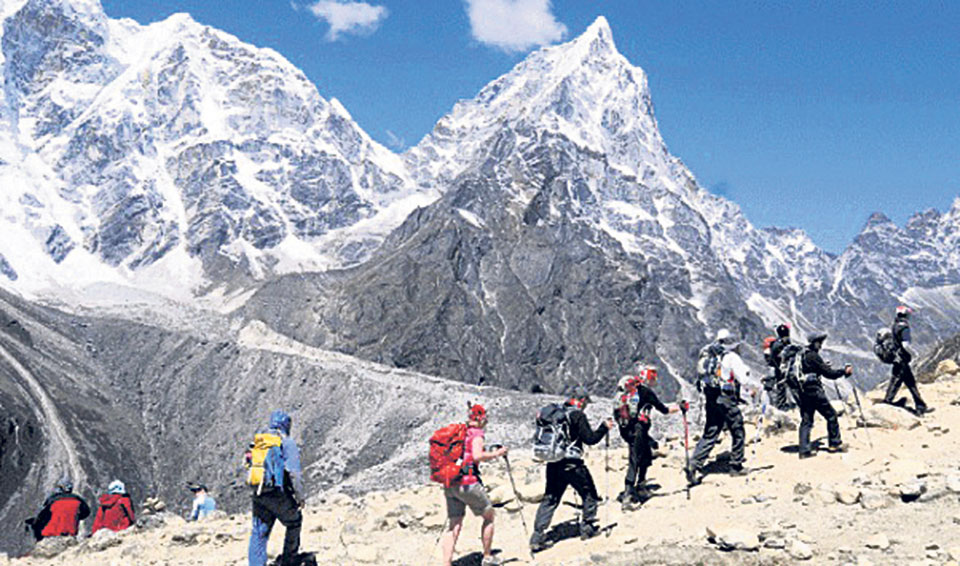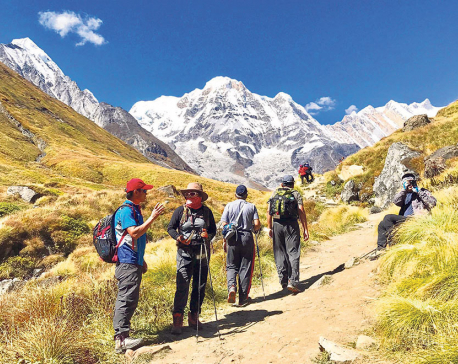
OR
Opinion

More from Author
Trekking is a huge business in Nepal with over 16 percent of tourists going on hiking and trekking trips in 2019 alone and 11 percent in 2021. From the Everest Base Camp trek to the northern trails of Upper Mustang, there are plenty of world-class treks that you can enjoy either solo or as part of a group trek.
There are pros and cons to both types of trek. A solo trek, for instance, affords travelers a lot of freedom over their itinerary and budget. A group trek, on the other hand, is a lot safer and convenient, with qualified guides leading the way and porters carrying your belongings. Let’s discuss what you stand to gain or lose, should you decide to go on a trek in Nepal all by yourself or in a group.
Pros and Cons of Solo Trekking
Solo trekking in Nepal can feel like one big adventure. Being alone among giant mountains can be liberating, but there are its drawbacks too. From the hassle of carrying your belongings to the new regulation restricting solo travel to most trekking sites, solo trekking can also be quite a daunting experience.
Pros
● More freedom in your route: If you’re not dependent on a group itinerary, you can pick your own route and schedule. You are also free to take alternative routes. Solo trekking definitely has a lot of freedom that you can take advantage of.
● You can take your time: As you’re not waiting on people at the back of the pack or racing to keep up with the daily schedule, you can set your own time and pace. If you want to stay in one place a day longer, you can do that.
● Often cheaper than group tours: Solo trekking is often cheaper than all-inclusive group tours, even with the costs of hiring a guide, securing entry permits, and accommodations.
Cons
● Not always as safe: Solo trekking comes with risks, which is why guides are a legal necessity on a lot of routes now. Group treks offer safety and insurance coverage.
● Limited routes due to new regulation: The Nepal Tourism Board (NTB) has banned solo trekking in many national parks and protected mountain regions. So if you want to trek solo, you might have to contend with the routes that are exempt from this rule.
● Logistical challenges: When trekking alone, you need to carry all your belongings and gear or organize your own portage system from stop to stop.
Pros and Cons of Group Trekking
From the benefits of having everything organized in advance for you and the opportunity to make new friends, to the downsides of cost and strict schedule, there’s a lot to think about when joining a group trek.
Pros
● Safety in numbers: On the mountains, being in a group is always a good idea. You will be safe in the hands of experienced guides who know what they’re doing, and your fellow travel companions.
● Logistics are sorted out for you: One of the biggest perks of group trekking in Nepal is the fact that porterage, campsites, tea houses, food, and insurance are all organized for you. You can just relax and enjoy the trek.
● New friends along the way: A great thing about group trekking is that you meet like-minded people who are interested in the same things as you. You can make friends for life.
Cons
● Can be expensive: All-inclusive group treks in Nepal don’t come cheap. You’re paying for convenience and that comes at a premium.
● Limited dates and routes: With a group trek, you’re tied to certain dates and routes dictated by the travel operators.
Best Routes for Solo and Group Trekking
You can find plenty of routes that are perfect for solo trekking all around Nepal. Popular solo trek routes include the 11-day-long Langtang Valley Trek in north-central Nepal. It’s a relatively short trek with not many challenging uphills. It can be done without a guide as you will be following the Langtang River the whole way.
If you’re trekking as a group, there are a lot more routes open to you. Some of the best routes for group trekking include the Annapurna Circuit which takes you through the stunning Thorong La Pass, leading to outstanding mountain vistas. Essentially, any of the super popular Nepalese trekking locations are going to be serviced by group tours.
Solo Trekking Banned in Nepal
You might have heard about solo trekking being banned in Nepal from 1 April, and this is true to a degree and is going to affect trekking tourism in the country. According to the reports from the Nepal Tourism Board, out of around 170,000 trekkers in 2019, nearly 46,000 trekked solo. That’s over a quarter of the trekkers in Nepal that would have to adapt to the new regulation. Even during the COVID-induced travel slump period in 2021, out of around 8,000 trekkers, almost 900 were individual trekkers. Given that many travelers to Nepal are backpackers, this could deter them from joining trekking trips that mandates having a guide.
The new rule applies to many national parks and protected mountain areas. This means popular trekking routes like Manaslu Circuit, Annapurna Circuit, and Upper Mustang all need guides, which can be an additional expense for solo travelers. One exception is Everest Base Camp, a major bucket list trek destination for many solo travelers visiting Nepal.
So there are pros and cons for both solo and group trekking in Nepal. However, with the new ban on solo trekking in popular areas, it seems like tourists are going to have to opt for group trekking if they wish to see Nepal’s mountains and national parks.
You May Like This

Trekking Trails on the rise
POKHARA, Dec 5: Around 70 percent of tourists visiting Nepal travel through different trekking trails in the country. Nepal is... Read More...

Oman crush Nepal in final group match
KATHMANDU, Nov 8: Nepal suffered fourth and final straight defeat in the AFC U-19 Championship 2018 Qualifiers, as it went... Read More...

Dortmund holds Madrid 2-2 to win group, break scoring record
MADRID, Dec 8: With a late equalizer by substitute Marco Reus, Borussia Dortmund drew 2-2 with defending champion Real Madrid... Read More...




Just In
- CM Kandel requests Finance Minister Pun to put Karnali province in priority in upcoming budget
- Australia reduces TR visa age limit and duration as it implements stricter regulations for foreign students
- Govt aims to surpass Rs 10 trillion GDP mark in next five years
- Govt appoints 77 Liaison Officers for mountain climbing management for spring season
- EC decides to permit public vehicles to operate freely on day of by-election
- Fugitive arrested after 26 years
- Indian Potash Ltd secures contract to bring 30,000 tons of urea within 107 days
- CAN adds four players to squad for T20 series against West Indies 'A'














Leave A Comment